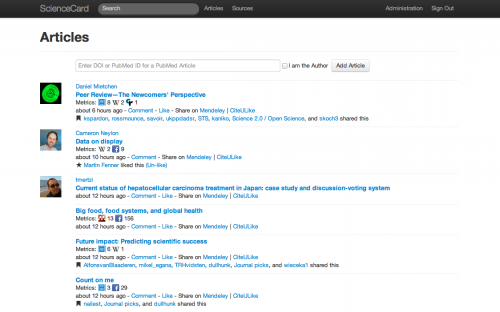Almost exactly a year ago (in the hackathon of the Science Online London 2011 conference) I started the ScienceCard project. ScienceCard is a fork of the Open Source PLOS Article-Level Metrics (ALM) code, personalizing the Article-Level Metrics.
A lot has happened in the last 12 months, most importantly that I started to work for PLOS as technical lead for the Article-Level Metrics project in May. In July, version 2.0 of the PLOS ALM application was released, and the code made available on Github. This not only means that everyone can install his own ALM application (assuming some familiarity with the Ruby and Rails web framework), but that we can fork the code and modify it.
Although my focus is now clearly on improving the PLOS application, it didn’t feel right to shut down the ScienceCard project. I really like the idea of personalized Article-Level Metrics (something I spoke about at the altmetrics12 conference). So I sat down the last two weekends to upgrade ScienceCard to the PLOS ALM 2.0 code (the source code of my fork can be found here). With the imminent launch of the Open Researcher & Contributor ID (ORCID) service next month I dropped the functionality to get all articles by a particular person from Microsoft Academic Search. For now you can add your articles by DOI or PubMed ID (currently only articles from PubMed), but you can now also add interesting articles not authored by you. This makes ScienceCard a nice tool to try out the PLOS ALM code without installing the software. Please remember that all metrics are collected in the background, so it can take a few hours until they show up for newly added articles.
ScienceCard also shows the power of open source software. Open source doesn’t simply mean free software, it means that you can modify the code if your requirements are different. For ScienceCard I added authentication via Twitter (required to add articles, I don’t want to deal with usernames and passwords), a simple lookup by DOI or PubMed ID (something not needed if you are publisher of the article and have that information), and comments and likes. Article-Level Metrics is not about collecting numbers, it is about capturing the activity surrounding an article post-publication.


